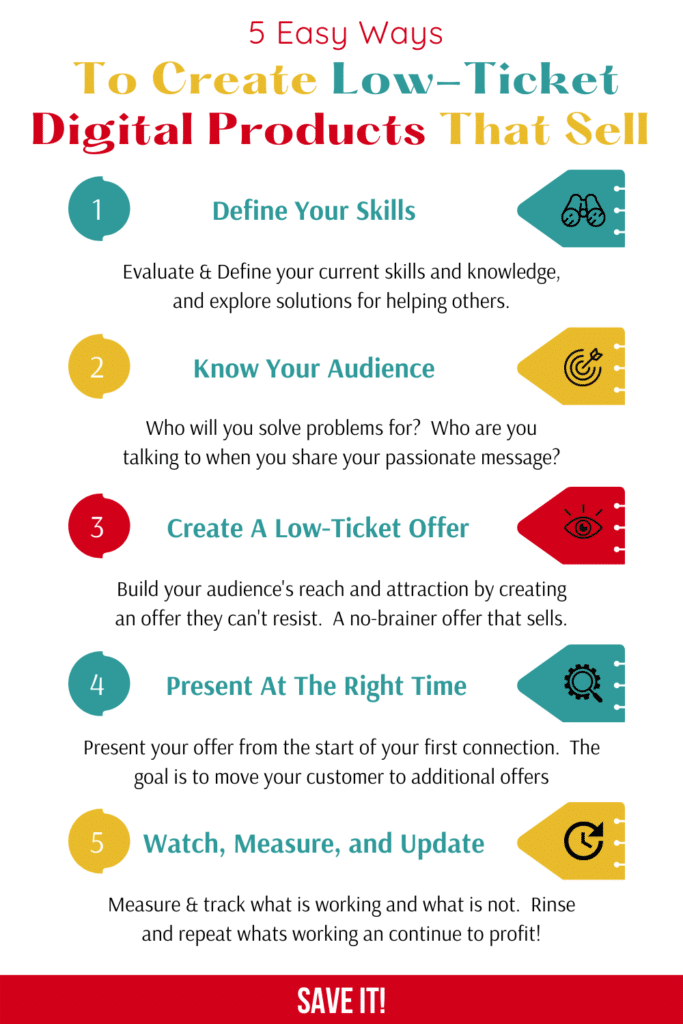If you're going to create an online course that sells your skills and knowledge then I say make it a low-ticket offer to start. A low-ticket offer, as a general guideline, is a product with a price tag of $50 or less. These low-cost items are usually digital products, like an eBook, video course, online class, or resource guide. A low-ticket offer, if chosen wisely, is a powerful way to qualify leads and drive sales.
As your prospects progress through your sales funnel, various offers direct them towards the ultimate destination: your core offer. Your core offer usually consists of a higher-priced item at the end of the funnel.
By presenting prospects with a low-ticket item up from the start or top of your funnel, you can gauge whether they have true customer potential or if they’re just freebie seekers. If they purchase your inexpensive offer, you can start building a relationship with them and priming them for future purchases.
There are several benefits to pitching low-ticket offers.
Low-ticket offers provide you with another way to earn income. They are usually digital products, so they cost very little to produce and have no delivery or storage fees. It’s just an electronic file, so your margin is high, even if you’re only charging few dollars. Although the primary focus is your core offer, these small products can generate some money and offset any expenses associated with your higher-ticket items.
The reason low-ticket offers work well near the beginning of a sales funnel is that they help to qualify leads. Many people who sign up for your lead magnet are only after the freebies. They’ll consume your content in exchange for their email address, but they have no intention of paying even a few dollars for a premium product. A low-ticket offer helps you identify these people right away.
Low-ticket offers also help build relationships with new leads. By providing your target audience with an instant solution at a reasonable price, you establish trust and these customers will want to learn more.
This inexpensive offer also provides an opportunity to demonstrate your expertise. Use your low-ticket offer to showcase your knowledge and the results you can deliver, and your customers will be more likely to purchase future offers with higher price tags.
Low-ticket offers move prospects closer to your core offer and weed out those who won’t buy. It’s a low-risk and valuable lead qualification tool that costs very little to produce and distribute.
Sometimes business owners can make creating online courses harder than it should be. The goal for any online business owner should be to build your audience by improving the know, like, and trust factor. To do this, your audience has to trust you, and what better way to gain trust than with a low-ticket product. Here are some examples of quick and easy low-ticket products.

How do you maximize the effectiveness of your low-ticket offer? Get to know your audience. If you understand the issues they face, you can develop a low-ticket offer that will solve a particular problem for them and increase the likelihood of future purchases.
The best way to get a clear picture of your audience is to create an ideal customer profile. This process involves imagining your target audience as an individual – the one person who would most benefit from your core offer. Get to know their likes and dislikes, problems, and passions. This description will be a valuable tool when developing all of the offers in your funnel.
One low-ticket offer isn’t going to completely transform the customer’s life, but it should offer a “quick win” and a concrete improvement, no matter how small.
It’s not necessary to invest a lot of money into the production of a low-ticket offer. But what it can cost you is time and energy. Content creation can easily become a burden and a drain on your resources.
Since the key to generating income with a low-priced product is to cut overhead, look for shortcuts to content creation. A few ideas include:
The standard practice is to present prospects with a low-ticket offer at the beginning of the sales funnel, so you can start qualifying leads right away. But sometimes, it may be beneficial to engage with the prospect a bit more before pitching paid products. Think about your ideal customer and what they would prefer. For some people, and particular types of products, a low-ticket offer may be more appropriate later in the funnel.
Or, conversely, you can offer a low-ticket item as a lead magnet, at the front of your funnel. To do this, you would create a dedicated landing page and drive traffic to it. Once they purchase it, customers are added to your email list, where you can then start communicating with them.
There is no perfect place or time to present your low-ticket offer. Map out the customer journey through your sales funnel and experiment to see what works best for your target audience.
Track your results, check conversions, and then make the necessary adjustments. It will take some trial and error to perfect your low-ticket offer strategy, but once you do, it will be worth the effort.
Once you create one low-ticket repeat what's working and start your second low-ticket offer.
Are you ready to learn, step-by-step, how to create a low-ticket offer that will earn you more and qualify prospects for your core offer?
Join the next low-ticket workshop to learn how to increase your profits by selling your knowledge and skills with low-ticket offers.
